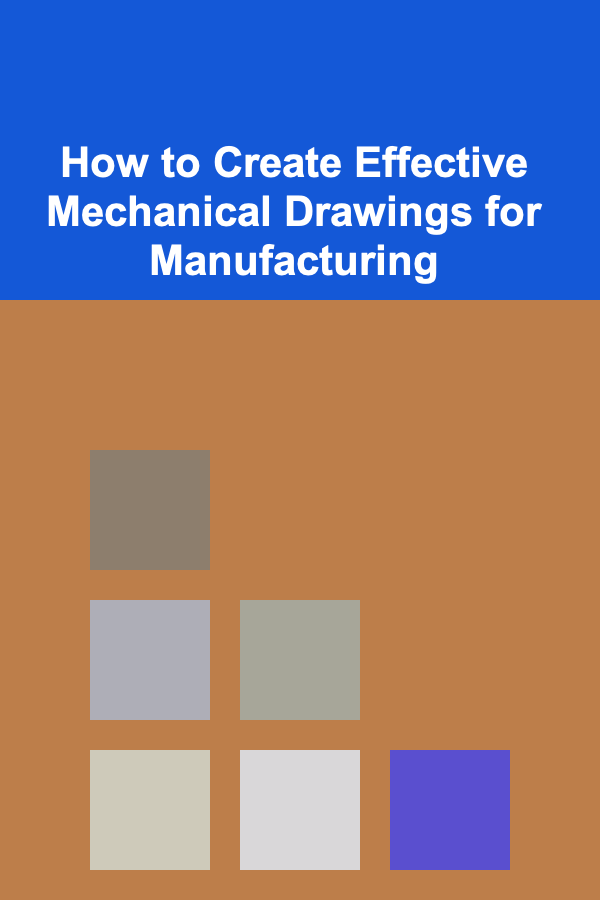
How to Create Effective Mechanical Drawings for Manufacturing
ebook include PDF & Audio bundle (Micro Guide)
$12.99$11.99
Limited Time Offer! Order within the next:

In the world of manufacturing, mechanical drawings are a critical tool for conveying design specifications and instructions. They provide precise visual representation of mechanical components and assemblies, ensuring that the manufacturing process can proceed smoothly and efficiently. Whether you're a seasoned designer, an engineer, or a manufacturer, creating effective mechanical drawings is a skill that requires careful attention to detail, technical knowledge, and a deep understanding of the manufacturing process.
In this article, we'll explore how to create effective mechanical drawings for manufacturing. From understanding the fundamentals of technical drawing to mastering the specific conventions and standards that guide the creation of manufacturing drawings, this guide aims to equip you with the tools necessary for success.
Understanding the Purpose of Mechanical Drawings
Mechanical drawings are visual representations of mechanical components, assemblies, and systems. They are used in the manufacturing process to communicate the design intent and specifications of a product. These drawings are essential for the following reasons:
- Clarifying Design Intent: Mechanical drawings are the primary method of conveying a designer's vision and ideas to manufacturers and other stakeholders. They ensure that everyone involved in the process understands the product's design and specifications.
- Providing Detailed Information: Effective mechanical drawings provide critical information on dimensions, material specifications, surface finishes, tolerances, and assembly instructions. This enables manufacturers to create the component accurately and consistently.
- Ensuring Quality Control: With clear and precise mechanical drawings, manufacturers can avoid mistakes and ensure the end product meets the required quality standards. Drawings also play a crucial role in testing and inspecting the finished product.
- Facilitating Communication: Mechanical drawings serve as a universal language in the manufacturing world. By adhering to standard conventions and symbols, designers and manufacturers can communicate effectively, regardless of language barriers.
Thus, the goal of a mechanical drawing is not only to represent the object but also to provide all the technical information necessary for its accurate reproduction in the manufacturing process.
Fundamentals of Mechanical Drawing
To create effective mechanical drawings, it's important to understand the fundamentals of technical drawing. These include:
- Orthographic Projection: This is the standard method for representing a three-dimensional object in two dimensions. In orthographic projection, the object is shown in multiple views (usually front, top, and side) to convey all of its dimensions and features. These views are aligned and scaled to ensure accuracy.
- Isometric Projection: In an isometric projection, the object is shown at an angle, providing a more "3D-like" representation. This is useful for showing how parts fit together in space.
- Sectional Views: Sectional views are used to show the interior features of an object. A part of the object is "cut away" to reveal the internal details, which is especially helpful for complex components.
- Dimensions and Tolerances: Dimensions are numerical values that specify the size of a part or feature. Tolerances indicate the permissible limits of variation for these dimensions. Proper dimensioning and tolerance specifications are critical for ensuring that parts fit together as intended and that they meet performance requirements.
The Basics of Drawing Lines and Shapes
The lines and shapes used in mechanical drawings are highly standardized. Here are some key elements:
- Continuous Thin Line: This is used for visible edges and outlines.
- Dashed Line: Indicates hidden edges that are not visible in a given view.
- Center Line: This line is used to mark symmetry and locate centers of circles or arcs.
- Dimension Line: This indicates where measurements are taken, and it often includes a small arrowhead at both ends.
Tools for Creating Mechanical Drawings
A wide range of tools can be used to create mechanical drawings. Traditionally, mechanical drawings were done by hand using drawing boards, rulers, compasses, and other drafting tools. Today, however, most mechanical drawings are created using Computer-Aided Design (CAD) software such as AutoCAD, SolidWorks, or CATIA.
CAD software has revolutionized the process of creating mechanical drawings. It allows for precise, editable drawings, quick modifications, and the ability to generate 3D models in addition to 2D drawings. However, regardless of whether you're working with traditional tools or modern software, understanding the fundamental principles of technical drawing remains critical.
Choosing the Right Type of Drawing for Manufacturing
Depending on the complexity of the product, mechanical drawings may vary in type and format. Different types of drawings are used for different purposes, and each drawing serves to provide the manufacturer with specific information.
3.1 Part Drawings
A part drawing focuses on a single component. It is used to specify the exact dimensions, material specifications, and tolerances for a specific piece. These drawings are especially useful for simple, standalone components that do not require further assembly.
3.2 Assembly Drawings
An assembly drawing shows how various parts fit together to form a complete product or system. This type of drawing provides a view of the overall assembly, along with the necessary instructions on how to assemble the components.
In addition to the basic component drawings, assembly drawings often include exploded views, which show the components separated but aligned, allowing the manufacturer to visualize how the parts fit together in space.
3.3 Detail Drawings
A detail drawing provides more in-depth information on a specific part or feature of an assembly. For example, if a part is complex and requires special attention, a detail drawing may highlight that section and show additional views or details such as threads, grooves, or material finishes.
3.4 Weldment Drawings
Weldment drawings are specifically used for designs that involve welding. These drawings include detailed instructions on the welding process, such as welding symbols, material specifications, and weld sizes.
3.5 Schematics and Diagrams
For assemblies involving electrical or mechanical systems, schematics and diagrams are used to represent how different elements interact. These types of drawings focus on functional relationships between components rather than physical representations.
Each type of drawing has its own role in the manufacturing process, and selecting the appropriate type is essential for communicating the design intent effectively.
Dimensioning and Tolerancing
Accurate dimensioning and tolerancing are among the most critical aspects of creating effective mechanical drawings. Improper or unclear dimensioning can lead to errors in manufacturing, resulting in costly mistakes or faulty products.
4.1 Basic Dimensioning
The basic dimensioning system involves specifying the exact measurements of parts and features. Dimensions should be placed on the drawing using dimension lines, arrows, and numeric values, ensuring that they are clear and easy to interpret.
When dimensioning, it's essential to follow certain guidelines:
- Avoid Redundant Dimensions: Don't dimension the same feature in multiple places. Redundant dimensions can confuse manufacturers and may lead to inconsistencies.
- Use Consistent Units: Always use the same units of measurement (e.g., millimeters, inches) throughout the drawing. This ensures that there is no ambiguity.
- Place Dimensions Outside the Drawing: Dimensions should be placed outside the actual object outlines to prevent overlap and maintain clarity.
4.2 Tolerances
Tolerances are the allowable deviations from the specified dimensions. They are crucial for ensuring that parts fit together even if there are small variations in the manufacturing process. Tolerances can be specified as limits (e.g., 50 mm ± 0.5 mm) or as a range (e.g., 50 mm ± 1 mm).
Types of tolerances include:
- Linear Tolerances: These are used for specifying the permissible deviation in the length, width, or height of a part.
- Geometric Tolerances: These specify the permissible variation in the shape or orientation of a part, including features like flatness, roundness, and perpendicularity.
Applying the correct tolerances is vital for ensuring that parts fit together properly and function as intended.
Standards and Conventions in Mechanical Drawings
Mechanical drawings are governed by international standards that ensure consistency and clarity across the industry. These standards define conventions for the layout, symbols, and language used in technical drawings.
Some of the most widely recognized standards include:
- ISO (International Organization for Standardization): ISO standards for technical drawings cover everything from the size and layout of drawings to specific rules for dimensioning and tolerancing.
- ASME (American Society of Mechanical Engineers): ASME Y14.5 is the standard for dimensioning and tolerancing used in the United States. It provides detailed guidance on how to apply tolerances and create clear mechanical drawings.
- DIN (Deutsches Institut für Normung): DIN is the German standard for technical drawings, similar to ISO but more commonly used in European countries.
These standards ensure that mechanical drawings are universally understood and can be interpreted correctly by manufacturers around the world.
Review and Quality Assurance
Once a mechanical drawing is created, it must go through a review process to ensure that it is accurate, complete, and ready for manufacturing. This review process may involve multiple stakeholders, including designers, engineers, and quality control personnel. They will check for the following:
- Accuracy of Dimensions: Are all the dimensions correct and consistent? Are the tolerances appropriate for the manufacturing process?
- Clarity of Instructions: Are the instructions clear and unambiguous? Can the manufacturer understand the design intent?
- Completeness of Information: Does the drawing include all necessary views, dimensions, and details? Are materials, finishes, and other specifications clearly stated?
- Compliance with Standards: Does the drawing conform to relevant standards and conventions?
Quality assurance checks at this stage help prevent errors and ensure that the drawing can be used effectively in the manufacturing process.
Conclusion
Creating effective mechanical drawings for manufacturing is a complex but rewarding task that requires technical knowledge, attention to detail, and an understanding of manufacturing processes. By following the principles outlined in this article, designers and engineers can create drawings that not only convey their ideas clearly but also help manufacturers produce high-quality products.
Remember, mechanical drawings are more than just pictures---they are essential tools for communication, ensuring that a design is realized accurately and efficiently. Whether you're working on a simple part or a complex assembly, mastering the art of creating precise and effective mechanical drawings is key to success in the manufacturing industry.
Reading More From Our Other Websites
- [Home Family Activity 101] How to Create a Cozy Reading Nook for Family Storytime
- [Home Staging 101] How to Add Curb Appeal to Your Home for a Better First Impression
- [Home Pet Care 101] How to Create a Home Pet Spa Day: Pamper Your Pet with These Easy Ideas
- [Home Rental Property 101] How to Minimize Vacancy Rates in Your Rental Property
- [Organization Tip 101] Best Organization Hacks for ADHD: Strategies for Focus & Productivity
- [Home Lighting 101] How to Incorporate Task Lighting into Your Home's Design
- [Gardening 101] Finding Your Perfect Fit: How to Choose the Right Garden Climate Zone
- [Home Family Activity 101] How to Have a Family Bake-Off for the Best Treats
- [Home Holiday Decoration 101] How to Incorporate Eco-Friendly Holiday Decorations
- [Home Budget Decorating 101] How to Make a Room Feel Bigger on a Budget

How to Make a Checklist for Car Cooling System Maintenance
Read More
How to Prepare for Dietary Restrictions in Your Menu
Read More
How to Save Money on Banking Fees: Tips for Every Account Holder
Read More
How to Use a Vision Board for Home Organization Goals
Read More
How to Navigate Religion and Spirituality in Dating
Read More
How to Design a Pollinator-Friendly Garden: A Comprehensive Checklist
Read MoreOther Products

How to Make a Checklist for Car Cooling System Maintenance
Read More
How to Prepare for Dietary Restrictions in Your Menu
Read More
How to Save Money on Banking Fees: Tips for Every Account Holder
Read More
How to Use a Vision Board for Home Organization Goals
Read More
How to Navigate Religion and Spirituality in Dating
Read More